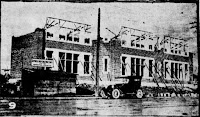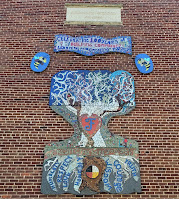© 2022, Christian Cassidy
Place: Faraday School
Address: 405 Parr Street (Map)
Built: 1922
Architect: John Semmens
Contractor: Sutherland Construction
The
North End was one of the fastest growing neighbourhoods in Winnipeg
immediately following the First World War. To alleviate overcrowding at
area schools, plans were made for a new 14-room school building on Parr
Street at Mountain Avenue.
Sutherland Construction won the contract to build the two-storey with basement building in May 1922 with a bid of $76,550.
Before construction began it had already been decided that the school would be named for British scientist Michael Faraday, (1791 - 1867). In 1831, he discovered electromagnetic induction which is the principle behind the electric transformer and generator. In May 1924, Mayor S. F. Farmer and school board chair F. S. Harstone
unveiled a picture and commemorative tablet at
the school to honour Faraday.

July 22, 1916, Winnipeg Tribune
Faraday School was designed by John N. Semmens
Originally
from Ontario, Semmens attended Wesley College in Winnipeg before going
to the School of Architecture at the University of Pennsylvania. Upon
graduation, he found work with New York City's prestigious firm McKim Meade and White.
Semmens' first Winnipeg project was for his New York employers - the Bank of Montreal Building at Portage and Main (1910). He then settled here and started a firm of his own. Early commissions include the McCormick Building on Henry Avenue (1912) and the St. John's Branch of the Winnipeg Public Library (1914).
The war interrupted Semmens' career when he went overseas as an officer with the 78th Battalion (Winnipeg Grenadiers).
He fell seriously ill in 1916 but recovered and rejoined his unit. In
early 1918, he was promoted to the rank of Lieutenant-Colonel and became
the commanding officer of the 78th. At the end of the war he was
awarded the Distinguished Service Order.
Semmens
resumed his practice after the war and became the consulting architect
for the Winnipeg School Division which had a backlog of projects due to
shortages of materials and manpower caused by the war.
Just as J. B. Mitchell created his basic school design with Alexandra School
and replicated it with just minor variations to fit other sites,
Semmens did the same. (Mitchell was still the superintendent of schools
at this time but the architectural work was farmed out.)
Semmens' go-to design was in red brick with Tyndall Stone trim in a Gothic Revival or "Collegiate Gothic"
style that included elements such as decorative parapets and arched
doorways. One of the more delightful aspects of Collegiate Gothic is the
decorative stonework that can include things like grotesques. Both
Faraday School and Daniel McIntyre Collegiate have them.
Several Semmens-designed schools were under construction in 1922, including Daniel McIntyre Collegiate, Grosvenor, and David Livingstone, and all share a similar appearance.
When
Faraday School officially opened on December 1, 1922, it became the
home to nearly five hundred students who were transferred from Margaret
Scott, Strathcona, and Ralph Brown schools as well as two temporary
classrooms that were meeting at a nearby Ukrainian hall.
It was
referred to most often as a junior high school but newspaper articles indicate
that at times it had students from kindergarten right through to grade nine. It wasn't
until the late 1960s that it was referred to as Faraday Elementary
School.
The first principal was Archer F. Goodridge who was followed by C. C. Cornish in 1925.
Faraday
School soon became overcrowded and in May 1925 the school board awarded
a $50,400 contract to Borrowman and Jamieson to build a two-storey with
basement, 75 foot x 100 foot extension to house ten additional
classrooms. It was also designed by Semmens.
The extension opened by the end of the year and brought the school's population to nearly 900 students.
As
this post-war boom settled down, another came in the 1950s. North
End schools found themselves overcrowded again and in order to cope with the
"Baby Boom" some expanded, though not Faraday, whilst others had to
double-up some classes with staggered starting hours and yet others had
to take in additional grades.

March 5, 1936, Winnipeg Free Press
Faraday
School proved to be a sports powerhouse in the late 1930s and early
1940s with its junior or senior boys teams winning the school division's
soccer championship three times. There was also an ongoing connection
to animals, both alive and dead.
In the mid to late 1930s,
Faraday had a Junior Humane Society Club that met every two weeks under
Miss D. M. Allison. Students were allowed to bring in their pets from
home for the period to show them off to the class.
The school also sported a large "natural history collection" of stuffed animals thanks
to Olive Armstrong, its science teacher from 1927 to 1942.
The
first newspaper reference of the collection comes in October 1929 when a
gyrfalcon measuring 23 inches in length was found dead near Stony
Mountain and brought to Armstrong "who promptly took steps to have
the specimen preserved for the Faraday school collection." The
following year, it was reported that Armstrong received a Northern Raven
measuring 25.5 inches that had been shot near Selkirk and a Tennessee
warbler found dead in the November cold.
The collection wasn't
restricted to birds. At the 1930 Manitoba Education Association
conference in Winnipeg there was an exhibit from the school's collection
that included a stuffed jack rabbit, owls (plural!), a beaver,
"and others of the smaller fauna".
It is unclear what became of the school's collection after Armstrong's departure.
Armstrong,
(later Olive Hensley), taught at a number of other city schools before
becoming the first principal of Rockwood School in 1950 and then a science
teacher at the Manitoba Teachers' College. She co-authored a science
textbook that was used in Winnipeg schools for a number of years, (Science Indoors and Out - Book One does not carry her name but a revised version circa 1950, called "Book Two", does.)
She
was a member of the executive of the Manitoba chapter of the Royal
Astronomical Society of Canada and a researcher/consultant for a
four-part 1962 CBC-TV series called The Evolution of Life presented by
Dick Sutton, director of the Manitoba Museum.
British-born Cornish was also well known in the local sports community as a promoter of children's sports leagues and a one-time president of the St. John's Curling Club.
A Clifford Cornish memorial award was given out each year at the school until at least 1951 to the student with the best academic and general proficiency. Funds for the award were raised at the school's annual tea.
There
were, of course, many alumni of Faraday School who fought in the Second
World War. One who didn't make it homes was Pilot Officer Albin Lucki.
Born
in Komarno Manitoba, his family later moved to Winnipeg where he
attended Faraday School, St. John's College, and the Winnipeg Normal
School. He then went to Angusville to start his teaching career.
Lucki
enlisted with the Royal Canadian Air Force in January 1941 and
graduated from his air training class at Rivers, Manitoba in October.
On May 31, 1942, Lucki's Wellington bomber was returning from operations over Germany when it crashed in the North Sea
off the Essex coast. Lucki and two other crew members were declared
missing in action and the following year were "for official purposes
presumed dead." He was 20 years old.
After the baby boom, the school's population dropped to about 360 students and the only new feature required was a modern gymnasium wing with taller ceilings and space that could be more easily converted into a temporary lunch room.
The parent council began lobbying for a new gym in 1969 but the school
board did not call for tenders until 1983. Even then, the process got
bogged down when the estimates came in much higher than expected.
Only
$477,000 was budgeted for the gym in October 1985 and to be able to
build it for that cost the building's roof height was lowered slightly and it was stripped of any unnecessary exterior features.
Faraday
School turns 100 in 2022. Events have included the addition of a mural
by Ursula Neufeld, the planting of more than a dozen new trees, and a June celebration for students past and present.
More images from Faraday School
The test was a success with teachers and civil defense officials reporting no children on the streets even ten minutes after the evacuation.
In the event of a real air raid, Faraday School would then be converted into a first aid/casualty centre.
Horne was an able seaman aboard the HMCS Nanimo who lost his life in June 1942. His devotion to duty was mentioned in dispatches after his death: "After the torpedoing of a merchant vessel. A.B. Horne was a member of the party which attempted to save the torpedoed vessel.... In the course of this brave and zealous attempt, A. B. Horne lost his life."
Columnist Vince Leah, a former teammate, noted in the Tribune in 1962: "Faraday school, where he spent many hours tutoring the youngsters in his beloved soccer, remembers him with a trophy which is presented annually to the school's outstanding student." (The award was likely for best athletic student.) A follow-up column by Leah in 1990 noted that the award was still given out.
School
patrols have been a familiar site at Faraday School since its first
year of operation. Though Louise Staples of Greenway School is credited with establishing the current school patrol program in 1936, schools like Faraday and Aberdeen had patrols as early as 1923.(To be fair, it was Staples' program that became he genesis for the provincial program we have now.)
Most notable about Faraday School today is its condition. Unlike some schools of this era which have been horribly renovated over the years, like David Livingstone, Faraday's renovations have been much more sympathetic.
Newer windows are the same size as the originals and boast what are now merely decorative mullions and muntins. Many floors have been restored rather than a new material laid over them.

















No comments:
Post a Comment